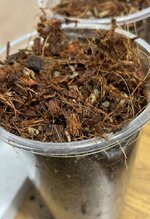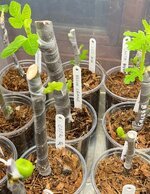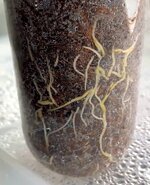Many Thais use plenty of lumpy coconut fiber when potting up their figs – it's a cheap, waste product over there – resulting in a fairly loose, airy substrate. I imagined this would soon dry out in the tropical sun, but this material seems to hold a lot of moisture, and fig roots seem to love it.
This got me thinking about experimenting with the stuff in my rooting substrate, so this year I have been using ONLY coarse coconut fiber, with about 5% pumice mixed in, to root some of my cuttings. This is not the usual fine coir, but stuff intended for growing orchids (though not the lumpiest type - kind of medium coarse). This means that there are large pockets of air in the mix. In a way this is the opposite of rooting in water, which allows the cuttings minimal air, a process which in my experience takes much longer than rooting in soil.
Well, so far the results are very promising. The first cuttings all took after a couple of weeks, and the front-runners are showing roots all around the cup.
PS To be able to push the cutting down into the coconut fiber I have to first make a hole with a sharp instrument. I used the shaft of a watercolor
paintbrush.



This got me thinking about experimenting with the stuff in my rooting substrate, so this year I have been using ONLY coarse coconut fiber, with about 5% pumice mixed in, to root some of my cuttings. This is not the usual fine coir, but stuff intended for growing orchids (though not the lumpiest type - kind of medium coarse). This means that there are large pockets of air in the mix. In a way this is the opposite of rooting in water, which allows the cuttings minimal air, a process which in my experience takes much longer than rooting in soil.
Well, so far the results are very promising. The first cuttings all took after a couple of weeks, and the front-runners are showing roots all around the cup.
PS To be able to push the cutting down into the coconut fiber I have to first make a hole with a sharp instrument. I used the shaft of a watercolor
paintbrush.



